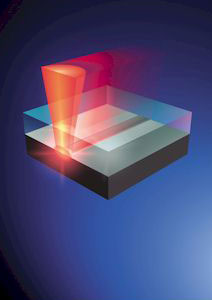Laser Welding
|
|
The laser beam penetrates the upper "transparent" component and is converted into heat by the absorbing lower component. Since both components need to be pressed together (as in other methods), heat is conducted from the absorbing lower component allowing both parts to melt and create a bond only where the laser beam is directed. Clamping of the plastic components that are to be assembled is still essential so that intimate contact is made to allow the laser beam to melt exactly where the parts need to be bonded together. Nearly all thermoplastics can be welded using the proper laser components. Special additives/pigments also allow laser welding of dark to dark materials as well as transparent to transparent combinations. It's all about color, specifically what color the laser thinks your part is. Parts that appear very dark to the human eye can be either transmissive or absorptive, depending on the formulation of the pigment. Even joints that require optical clarity (clear-to-clear) can be achieved. Laser welding of thermoplastics depends on many of the same rules of resin compatibility that the other processes do, but is more forgiving of resin chemistry or melt temperature differences than most other plastic welding processes. |
